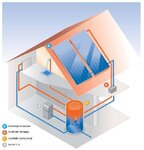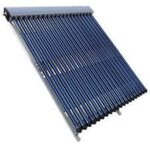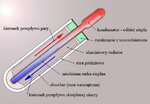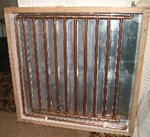Vermes
Advanced Member level 4

Home made solar collector is a good solution for those, who want to save money spent on central heating as well as water heating. Both costs still continue to raise due to the increase in fuel prices. Gas emission standards are also important to the heating issue. All that causes people get more interested in renewable sources of energy. Wind turbines, heat pumps and solar energy systems such as photovoltaic panels and solar collectors are important part of everyday life of many people. Household wind turbine can be a very efficient source of energy, although it requires several specific environmental conditions and significant investment of money. The same situation is with heat pumps – you need a lot of money to spend on them, and only after many years they can be profitable. Devices which use the solar energy are a different matter due to the fact that the production of solar energy absorbing materials has become a lot more profitable. Modern solutions are characterized by increased absorption of solar energy. Radiation of the sun can be converted into electrical energy through photocells. Electricity produced in that way is a very universal source of energy and can be used in many appliances – for direct water heating via a heater or it can be stored in accumulators. Adding an inverter allows you to supply household appliances, but remember that over time, the accumulators lose their properties, and storage of larger amounts of energy requires not one, but from a few to a dozen accumulators. Another thing that is worth considering, is that over time, photovoltaic panels gradually lose their efficiency.
Solar collectors which support heating water seem to be one of the most reliable ways of gaining free energy. Distribution of insolation in your area can be for example 60% of annual demand for hot water. Average cost of installation of a fabric set of solar panels is a quite significant expense in the family budget. When you decide to buy solar panels, there are few features which should be taken into account. One of them is very important parameter of solar panels – its efficiency. The surface of collectors should be selected carefully so that it does not produce excess of energy in the summer. Optimum solution for that problem is to use a heat buffer, which allows you to store heat. However, it has to be matched adequately to your needs so that the household members were able to use the heat accumulated in it. Every buffer, even the best one, has a certain amount of heat, which is irretrievably lost.

Diagram of a simple solar installation
Picture above presents a basic installation of water heating support system via solar panels. Cold water is pumped from a tank (boiler) to the solar panel, in which it is heated by the sun's rays. Then, hot water is pumped back to the tank, where, flowing through pipe coils, it heats utility water located in the tank. Most full-year installations require using a special solar fluid or glycol in solar collectors' cycle. The whole is controlled by a microprocessor system examining temperature of the boiler and the collector. If temperature of the factor is high enough, pump is turned on and heated fluid passes to the tank. A system with forced cycle requires continuous supply – lack of the supply may cause overheating of the factor and dangerous raise of pressure in the installation. To avoid such accidents, it is good to install expansion vessels which compensate the expansion of the fluid and bleed valves which provide leaking of the system when pressure exceeds a certain value. Driver of solar system can be also integrated with the central heating stove drive. The whole system can be designed so that the fluid circulates by gravity. Unfortunately, that solution requires installation of the tank above the solar panels. In addition, the system uses vents or air separators protecting against air circulation in the system. Air is very dangerous for pump as it may cause damage. It can also cause water flow disturbance or complete blockage of flow.
Collector:
Solar collector is used to convert solar radiation into heat energy. The sun heats the absorbent surface, which transfers the heat to the heating factor.
There are the following types of solar collectors:
Flat plate collector:
Flat plate collector used to be one of the most popular basic component of solar systems. Such device looks similar to a window. It consists of a frame and a special glass, under which there is a flat piece of copper plate with soldered channels for the heating fluid. The plate called absorber, is covered with a special coating that absorbs the maximum amount of sun rays. The most commonly used product for that purpose are: black chrome, titanium and silicon oxides, or special agents such as TINOX and BlueTec. The highest efficiency can be achieved by coatings of titanium compounds, however, they are the most expensive solution. An important disadvantage of flat plate collectors is that they are entirely dependent on the outside temperature. Low temperatures completely prevent correct operation, because the achieved energy is quickly put back to the atmosphere. Only rarely used vacuum flat plate collectors provide using their advantages in the winter.

Construction of a flat plate collector
Pipe collector:
Pipe collectors are a natural evolution of flat plate collectors. Most disadvantages of their precursors were removed. Construction of such devices is different than the construction of flat plate collectors. Heat is absorbed by the absorber installed inside a glass pipe filled with vacuum. Thus, the absorber keeps the maximum amount of heat, regardless of the outdoor temperature.

Pipe collector
There are two main kinds of pipe collectors. The principle of operation of the first one is that the heating factor flows directly through the pipes of absorbers, while the second one is equipped with a closed circuit of absorbers. Both of them consist of a copper pipe. A small amount of water has to be injected into that pipe under pressure. Under the influence of heat, the water begins to evaporate under pressure and begins to move in the direction of the capacitor. Heat is transferred from the capacitor to the glycol in bulk vessel located at the top of the collector.

Pipe of vacuum collector
Amateur constructions:
Due to the fact that solar installations are rather expensive, the Internet is full of home made constructions of solar panels. A lot of handymen build ther own collectors to save even more money (those spent on energy as well as on the device itself). Components for such construction can be found for example on a scrap-heap or disassembled of unnecessary devices. Amateur constructions are always flat plate collectors. Such a collector consists of a frame/housing, usually made of wooden blocks or angles. Old plat radiators or a sheet with attached copper coil act as the absorber.

Amatour collector with absorber made of copper pipes and steel sheet
Insulation:
Absorbing system should be carefully isolated from the environment. Insulation of the bottom and sides of the collector should be made carefully and using the best material possible. A good solution is to use mineral wool or foam. Do not use styrofoam as it can melt in higher temperatures. Another very important component is the glass used for closing the collector. The most important thing is the maximum transmission of solar radiation with a high level of thermal insulation. Too much heat lost through the glass significantly decreases the temperature produced by the collector.
Absorber:
Regardless of the type of absorber, it should be covered with a coating that will let you keep as much solar radiation as possible. Substance used for this purpose should have a good resistance to getting used and it should be flexible. Special attention should be paid to the thermal expansion of heat exchanger, which is exposed to severe temperature changes. Generat matt paints or special heat-resistant products (eg paints for dampers, fireplaces, etc.) are most commonly used for that purpose. Copper components are often blackened by chemical methods or by electrolysis in a solution of NaOH. You can also rub copper with an aqueous solution of potassium polysulfide and ammonium chloride. Of course, there is another way – you can apply coatings which are designed specifically for collectors (eg. Sunselect), but the cost of such preparations in retail can make the whole construction far too expensive.
Installation:
A collector is the main element of solar installation, but for correct operation it also requires other components – additional exuipment such as inlet and outlet pipes for fluid, pump and the control system. The whole installation should be performed very carefully and with regard to safety. Pipes and vessels should be well protected against undesired heat losses. Home made solar installation are very popular nowadays. Also, the devices have been still improved by their constructors. One example of a very successful invention proven in practice it using a storage tank which allows you to drain all water from the collectors. Stopping the pump results in a total drying of solar collectors. Certainly, this is a good protection against water freezing in the system. This also solves the problem of excess hot liquid when a tank is unable to accept more energy already. Another common construction is water meter allowing more control over the parameters of operation.
Tank (boiler):
A tank should be equipped with spiral coil. Cheaper „U-type” constructions unfortunately do not operate properly with solar panels. A minimum capacity of boiler for each 2 square meters of the surface of collectors is 100 liters. When you combine the solar installation with existing hot water boiler installation, use heat exchanger consisting of two exchangers. Collector circuit should be connected to the lowermost spiral. The optimal solution is the use of large heat buffers (greater than 1000 liters) to allow the maximum amount of heat to be stored on sunny days. That heat then can be used later for a few days.
Driver:
A simple differential controlled can be used for controlling the solar kit. That device should measure the temperature in the collector and compare it with the temperature measured in the tank. In the event of favorable conditions, the pump is activated by the driver and fluid is exchanged between the collector and the heat exchanger.
Are solar energy systems a profitable investment?
Sometimes you can hear that solar collectors are not such a good idea. In most cases, the complaints are about the boiling factor or leaks. They are a result of improper installation of equipment or the inadequacy of the system performance to the needs of users. Overheating the system can be caused by improper selection of the power generated by the solar kit. The cost of factory solar installation is not small. However, in some countries there is a possibility of obtaining a preferential loan with funding (up to 45%). Certainly the cost is much lower when a construction is home made. However, you need basic knowledge and good skills when you want to create a solar collector. Factory vacuum collectors can operate efficiently a whole year even at low temperatures. Flat plate collectors, both factory and home made, lose too much energy. Much more cost-effective investment in efficient solar installation is when you have a large family or the installation would provide heat to a workplace or hotel. Manufacturers of modern collectors ensure that their sets can save up to 60% of the domestic hot water costs throughout the year.
Solar collectors which support heating water seem to be one of the most reliable ways of gaining free energy. Distribution of insolation in your area can be for example 60% of annual demand for hot water. Average cost of installation of a fabric set of solar panels is a quite significant expense in the family budget. When you decide to buy solar panels, there are few features which should be taken into account. One of them is very important parameter of solar panels – its efficiency. The surface of collectors should be selected carefully so that it does not produce excess of energy in the summer. Optimum solution for that problem is to use a heat buffer, which allows you to store heat. However, it has to be matched adequately to your needs so that the household members were able to use the heat accumulated in it. Every buffer, even the best one, has a certain amount of heat, which is irretrievably lost.

Diagram of a simple solar installation
Picture above presents a basic installation of water heating support system via solar panels. Cold water is pumped from a tank (boiler) to the solar panel, in which it is heated by the sun's rays. Then, hot water is pumped back to the tank, where, flowing through pipe coils, it heats utility water located in the tank. Most full-year installations require using a special solar fluid or glycol in solar collectors' cycle. The whole is controlled by a microprocessor system examining temperature of the boiler and the collector. If temperature of the factor is high enough, pump is turned on and heated fluid passes to the tank. A system with forced cycle requires continuous supply – lack of the supply may cause overheating of the factor and dangerous raise of pressure in the installation. To avoid such accidents, it is good to install expansion vessels which compensate the expansion of the fluid and bleed valves which provide leaking of the system when pressure exceeds a certain value. Driver of solar system can be also integrated with the central heating stove drive. The whole system can be designed so that the fluid circulates by gravity. Unfortunately, that solution requires installation of the tank above the solar panels. In addition, the system uses vents or air separators protecting against air circulation in the system. Air is very dangerous for pump as it may cause damage. It can also cause water flow disturbance or complete blockage of flow.
Collector:
Solar collector is used to convert solar radiation into heat energy. The sun heats the absorbent surface, which transfers the heat to the heating factor.
There are the following types of solar collectors:
- flat plate (normal and vacuum)
- pipe (normal and vacuum)
- focusing
- special (non-standard performance)
Flat plate collector:
Flat plate collector used to be one of the most popular basic component of solar systems. Such device looks similar to a window. It consists of a frame and a special glass, under which there is a flat piece of copper plate with soldered channels for the heating fluid. The plate called absorber, is covered with a special coating that absorbs the maximum amount of sun rays. The most commonly used product for that purpose are: black chrome, titanium and silicon oxides, or special agents such as TINOX and BlueTec. The highest efficiency can be achieved by coatings of titanium compounds, however, they are the most expensive solution. An important disadvantage of flat plate collectors is that they are entirely dependent on the outside temperature. Low temperatures completely prevent correct operation, because the achieved energy is quickly put back to the atmosphere. Only rarely used vacuum flat plate collectors provide using their advantages in the winter.

Construction of a flat plate collector
Pipe collector:
Pipe collectors are a natural evolution of flat plate collectors. Most disadvantages of their precursors were removed. Construction of such devices is different than the construction of flat plate collectors. Heat is absorbed by the absorber installed inside a glass pipe filled with vacuum. Thus, the absorber keeps the maximum amount of heat, regardless of the outdoor temperature.

Pipe collector
There are two main kinds of pipe collectors. The principle of operation of the first one is that the heating factor flows directly through the pipes of absorbers, while the second one is equipped with a closed circuit of absorbers. Both of them consist of a copper pipe. A small amount of water has to be injected into that pipe under pressure. Under the influence of heat, the water begins to evaporate under pressure and begins to move in the direction of the capacitor. Heat is transferred from the capacitor to the glycol in bulk vessel located at the top of the collector.

Pipe of vacuum collector
Amateur constructions:
Due to the fact that solar installations are rather expensive, the Internet is full of home made constructions of solar panels. A lot of handymen build ther own collectors to save even more money (those spent on energy as well as on the device itself). Components for such construction can be found for example on a scrap-heap or disassembled of unnecessary devices. Amateur constructions are always flat plate collectors. Such a collector consists of a frame/housing, usually made of wooden blocks or angles. Old plat radiators or a sheet with attached copper coil act as the absorber.

Amatour collector with absorber made of copper pipes and steel sheet
Insulation:
Absorbing system should be carefully isolated from the environment. Insulation of the bottom and sides of the collector should be made carefully and using the best material possible. A good solution is to use mineral wool or foam. Do not use styrofoam as it can melt in higher temperatures. Another very important component is the glass used for closing the collector. The most important thing is the maximum transmission of solar radiation with a high level of thermal insulation. Too much heat lost through the glass significantly decreases the temperature produced by the collector.
Absorber:
Regardless of the type of absorber, it should be covered with a coating that will let you keep as much solar radiation as possible. Substance used for this purpose should have a good resistance to getting used and it should be flexible. Special attention should be paid to the thermal expansion of heat exchanger, which is exposed to severe temperature changes. Generat matt paints or special heat-resistant products (eg paints for dampers, fireplaces, etc.) are most commonly used for that purpose. Copper components are often blackened by chemical methods or by electrolysis in a solution of NaOH. You can also rub copper with an aqueous solution of potassium polysulfide and ammonium chloride. Of course, there is another way – you can apply coatings which are designed specifically for collectors (eg. Sunselect), but the cost of such preparations in retail can make the whole construction far too expensive.
Installation:
A collector is the main element of solar installation, but for correct operation it also requires other components – additional exuipment such as inlet and outlet pipes for fluid, pump and the control system. The whole installation should be performed very carefully and with regard to safety. Pipes and vessels should be well protected against undesired heat losses. Home made solar installation are very popular nowadays. Also, the devices have been still improved by their constructors. One example of a very successful invention proven in practice it using a storage tank which allows you to drain all water from the collectors. Stopping the pump results in a total drying of solar collectors. Certainly, this is a good protection against water freezing in the system. This also solves the problem of excess hot liquid when a tank is unable to accept more energy already. Another common construction is water meter allowing more control over the parameters of operation.
Tank (boiler):
A tank should be equipped with spiral coil. Cheaper „U-type” constructions unfortunately do not operate properly with solar panels. A minimum capacity of boiler for each 2 square meters of the surface of collectors is 100 liters. When you combine the solar installation with existing hot water boiler installation, use heat exchanger consisting of two exchangers. Collector circuit should be connected to the lowermost spiral. The optimal solution is the use of large heat buffers (greater than 1000 liters) to allow the maximum amount of heat to be stored on sunny days. That heat then can be used later for a few days.
Driver:
A simple differential controlled can be used for controlling the solar kit. That device should measure the temperature in the collector and compare it with the temperature measured in the tank. In the event of favorable conditions, the pump is activated by the driver and fluid is exchanged between the collector and the heat exchanger.
Are solar energy systems a profitable investment?
Sometimes you can hear that solar collectors are not such a good idea. In most cases, the complaints are about the boiling factor or leaks. They are a result of improper installation of equipment or the inadequacy of the system performance to the needs of users. Overheating the system can be caused by improper selection of the power generated by the solar kit. The cost of factory solar installation is not small. However, in some countries there is a possibility of obtaining a preferential loan with funding (up to 45%). Certainly the cost is much lower when a construction is home made. However, you need basic knowledge and good skills when you want to create a solar collector. Factory vacuum collectors can operate efficiently a whole year even at low temperatures. Flat plate collectors, both factory and home made, lose too much energy. Much more cost-effective investment in efficient solar installation is when you have a large family or the installation would provide heat to a workplace or hotel. Manufacturers of modern collectors ensure that their sets can save up to 60% of the domestic hot water costs throughout the year.